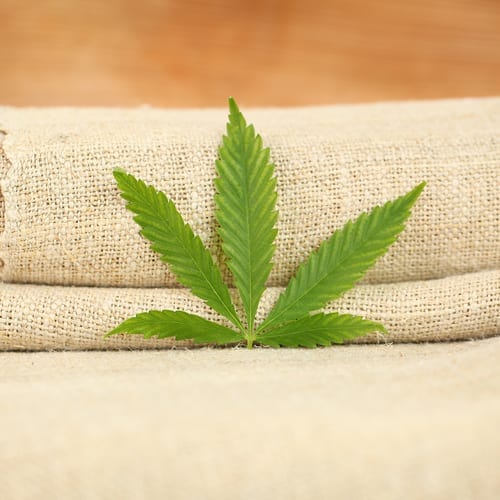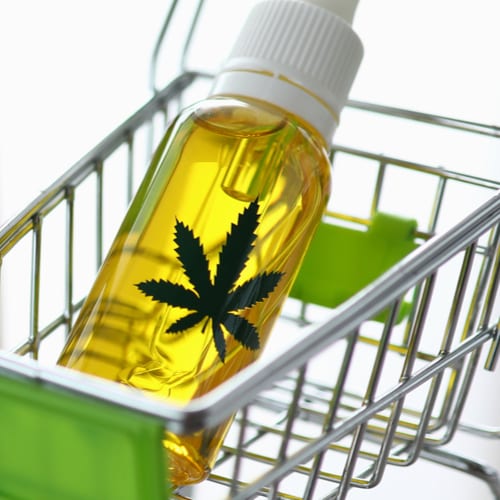
In late April, California allowed counties to begin issuing licenses for commercial industrial hemp production. The move was well received by stakeholders, who’ve been waiting to get started since the passage of the 2018 Farm Bill.
In removing hemp from the federal list of controlled substances, the 2018 Farm Bill legalized the plant across the United States. However, because state-level regulations were not yet in place, California growers and manufacturers could not partake in the business. Now, even with the approval of state regulations, which detail procedures for registration and collection of fees, there may be more hoops for those interested in hemp to jump through.
In recent weeks, both the California Department of Food and Agriculture and the California Farm Bureau Federation, a nonprofit representing most of the state’s county farm bureaus, have seen an increased interest in converting existing crops into hemp. Steve Lyle, a spokesperson for the Department, told Cannabis Wire that the agency’s staff “has received calls from hundreds of people from all over California.”
Omar Figueroa, a California-based attorney who specializes in the cannabis industry, also has clients looking to diversify their portfolios with hemp. The price per acre for hemp, he said, is far more appealing to farmers than other crops. Plus, hemp can be used to make thousands of products, increasing the possibility of potential revenue for those involved in manufacturing.
But the top-of-mind issue for growers, California Farm Bureau Federation spokesperson Taylor Roschen told Cannabis Wire, is how and when each county jurisdiction will authorize commercial cultivation.
The complications of local control
Just as cities and counties in California have the authority to decide whether to allow adult use cannabis sales within their jurisdictions, they can also make the same determination when it comes to the cultivation of hemp. And as with adult use cannabis sales, which continue to be banned in most of California, The Orange County Register recently reported that only twenty-two of the state’s fifty-eight counties to date are accepting hemp registration forms.
Local bans and moratoriums on hemp, Figueroa told Cannabis Wire, are often rooted in a jurisdiction’s wanting no association with cannabis. However, he noted, they’re also happening in cannabis-friendly areas like Mendocino County, on the state’s north coast, for an entirely different reason. There, officials have implemented a moratorium on hemp through February 2020—in an effort to prevent possible cross-pollination with cannabis.
It’s like that part in Jurassic Park where Jeff Goldblum says ‘Life finds a way.’
“Anecdotally,” said Figueroa, “it’s believed that cross-pollination can be prevented with, at least, a distance of ten miles between the plants. But there’s no reliable study.” Growers, he explained, “don’t want their carefully modulated strands of cannabis to be compromised. They don’t want to take that chance. It’s like that part in Jurassic Park where Jeff Goldblum says ‘Life finds a way.’”
Beyond cross-pollination concerns, crop conversion is not a clear-cut endeavor. Some conversions are apparently harder than others. When asked what types of farms are easiest or most difficult to convert to hemp, the California Farm Bureau Federation, said that alfalfa and almond farmers have expressed interest, but spokesperson Roschen said it greatly depends on a number of factors, including “locale, temperature, climate, water supply, varietal, and soil quality.”
This, he added,“highlights the need for applied research to ensure our growers who choose to transition or diversify their operation have a greater measure of confidence in making this choice.”
Meanwhile, said Roschen, though California has established a set registration fee and approved varietals, officials “must still promulgate regulations regarding testing and sampling procedures for the product thirty days before harvest.” County Agricultural Commissioners will then be required to put these standards into force. While the California Department of Food and Agriculture works to implement these regulations, “farmers and county officials only have some pieces of the puzzle,” Roschen said.
Late last week, Nicole Elliot, senior advisor on cannabis to Governor Gavin Newsom, signaled that the Department gave notice of proposed emergency regulations to establish time frames concerning these matters. In them, the Department indicates that, as of May 16, 2019, “there are 17 registered industrial hemp growers that represent a total of 2,166 acres of industrial hemp production.” Moreover, though “Dollar yields from industrial hemp vary wildly depending on the crop purpose (fiber, seed, or flowers) and cultivation method,” the Department calculates that the crop can generate some $20,000 per acre. Making its case for the need to adopt the emergency regulations, the Department then underscores that, “if the current California industrial hemp crop were to be destroyed because of the lack of an official industrial hemp sampling and laboratory testing protocol, it would result in a potential direct loss of over $43,000,000 to California farmers.”
How new state law could help
In the face of local control, some state lawmakers have moved to expand the amount of farmland available for cannabis and hemp cultivation. A recently-introduced bill, SB 527, for instance, would add language to state law clarifying that cannabis and hemp cultivation qualify as “agricultural” or “compatible uses” under certain land conservation contracts. Through these agreements, local governments provide landowners with reduced property taxes if they limit the use of their land to activities that are compatible with agricultural use. According to Harris Bricken McVay Sliwoski, LLP, a law firm with several practice areas, including the cannabis industry, current California law does not specify what land uses are “compatible” with agriculture and therefore “gives local governments ample discretion in making that determination.”
If SB 527 is implemented, the bill would expand “compatible uses” to include commercial cultivation of cannabis or industrial hemp. It would not, however, limit local governments’ ability to restrict or prohibit commercial cannabis and hemp. In practice, the Harris Bricken firm said in a blog post, the bill “could increase the supply of potential cannabis and hemp farmland by removing uncertainty about use restrictions.” It could also “force local governments to take an extra legislative step if they seek to prohibit cannabis or hemp uses.”
Extra benefits? Water conservation and jobs
On May 17, State Senator Scott Wilk, a Republican from Santa Clarita, delivered a keynote address at a ribbon-cutting ceremony at SoCal Farms in Lancaster, a city in northern Los Angeles County. The company, which began cultivating hemp through a memorandum of understanding with Antelope Valley College in 2014, was celebrating its first 100-acre harvest.
Back in February 2018, Wilk introduced SB 1409, a bill that streamlined industrial hemp production rules in California to make them comply with existing federal law. It also updated the definition of industrial hemp to reflect the difference between hemp and its higher THC cousin.
When the bill was passed, Wilk noted some of the benefits of joining the hemp industry in a statement, saying that “Industrial hemp is a natural fit for California’s arid climate. In the Antelope Valley, where alfalfa currently represents the No. 1 agricultural crop, farmers could save five acre-feet of water per acre when switching from alfalfa to hemp.”
Those savings, the senator underscored, are “important to the farming community, as well as the 40 million thirsty people living in California” who have been grappling with drought since 2011.
In a conversation with Cannabis Wire, Wilk doubled down on hemp’s potential environmental impact. California agriculture, he said, uses up 41% of the state’s water, yet it accounts for only two percent of the state’s GDP.
“I’m not advocating that we abandon agriculture,” Wilk added, “but we do have to be more strategic.” In comparison to hemp, other crops commonly grown in the region of California he represents—including alfalfa, onions, and carrots—consume a lot more water. Turning to hemp, Wilk concluded, can help revitalize the area “not only by putting our farmers back to work, but also through the creation of manufacturing jobs.”
Zac Cullen, VP of Sales and Marketing at SoCal Farms, said that this first 100-acre harvest is a type of internal “research project,” meant to inform the company about how hemp will fare in the Antelope Valley, which has a high elevation and a dry climate. The company’s goal is to offer consistent qualities of CBD full-spectrum oil to major manufacturers, in terms of taste, color, aroma, and level of cannabinoids. In collaboration with Antelope Valley College, SoCal Farms works to find optimal growing practices for hemp in the area’s microclimate.
Hemp, said Cullen, definitely consumes less water than alfalfa, but it is not inexpensive to grow. Still, hemp ultimately yields a larger margin than other crops that farmers have been cultivating in California. The numbers fluctuate, he added, but a higher margin of profit is almost guaranteed. In the future, SoCal Farms, which has access to land and, therefore, the potential to expand its operations from San Diego up to Fresno and in between, aims to become a fully vertically-integrated company. Currently, the company employs some 300 people at harvest time, along with fifty others year-round. The bulk of job growth in the company, Cullen said, will be in extraction and manufacturing.
Still, in addition to these promises and hurdles in the hemp industry, California lawmakers must once again get up to speed with federal policy to make it work. When the 2018 Farm Bill was signed into law, it generated new requirements. In response, Senator Wilk introduced another bill, SB 153, which would align California’s provisions regulating the cultivation and testing of industrial hemp with the 2018 Farm Bill.
Senator Wilk’s bill, which waspassed by the California Senate on May 22 and is now in the Assembly, has bipartisan support. “I am highly confident it will pass,” Wilk told Cannabis Wire.
When Wilk first started advocating for the hemp industry, he added, “a lot of people didn’t understand the difference between hemp and marijuana.”
“In fact, I still have to do a lot of education around that,” he said, “but not in the capital.”
Source: CannabisWire.com





